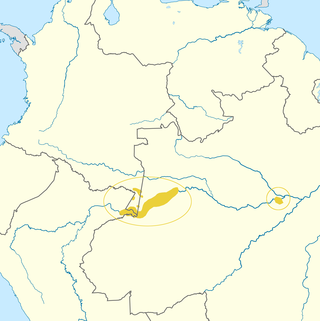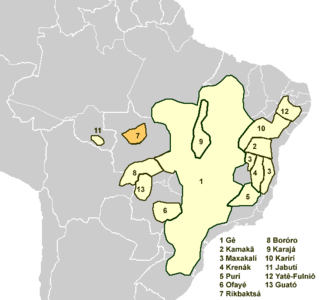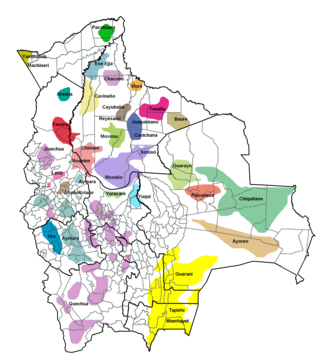
Pangasinan (Pangasinense) is an Austronesian language, and one of the eight major languages of the Philippines. It is the primary and predominant language of the entire province of Pangasinan and northern Tarlac, on the northern part of Luzon's central plains geographic region, most of whom belong to the Pangasinan ethnic group. Pangasinan is also spoken in southwestern La Union, as well as in the municipalities of Benguet, Nueva Vizcaya, Nueva Ecija, and Zambales that border Pangasinan. A few Aeta groups and most Sambal in Central Luzon's northern part also understand and even speak Pangasinan as well.
A.tong is one of the Garo dialect Sino-Tibetan language which is also related to Koch, Rabha, Bodo other than Garo language. It is spoken in the South Garo Hills and West Khasi Hills districts of Meghalaya state in Northeast India, southern Kamrup district in Assam, and adjacent areas in Bangladesh. The spelling "A.tong" is based on the way the speakers themselves pronounce the name of their language. There is no glottal stop in the name and it is not a tonal language.

Ticuna, Tikuna, Tucuna or Tukuna is a language spoken by approximately 50,000 people in the Amazon Basin, including the countries of Brazil, Peru, and Colombia. It is the native language of the Ticuna people and is considered "stable" by ethnologue. Ticuna is generally classified as a language isolate, but may be related to the extinct Yuri language and there has been some research indicating similarities between Ticuna and Carabayo. It is a tonal language, and therefore the meaning of words with the same phonemes can vary greatly simply by changing the tone used to pronounce them.

Mongsen Ao is a member of the Ao languages, a branch of the Sino-Tibetan languages, predominantly spoken in central Mokokchung district of Nagaland, northeast India. Its speakers see the language as one of two varieties of a greater "Ao language," along with the prestige variety Chungli Ao.

South Bolivian Quechua, also known as Central Bolivian Quechua, is a dialect of Southern Quechua spoken in Bolivia and adjacent areas of Argentina, where it is also known as Colla. It is not to be confused with North Bolivian Quechua, which is spoken on the northern Andean slopes of Bolivia and is phonologically distinct from the South Bolivian variety. Estimates of the number of speakers of South Bolivian Quechua range from 2.3 to 2.8 million, making it the most spoken indigenous language in Bolivia, just slightly greater than Aymara, with roughly 2 million speakers in Bolivia. In comparison, the North Bolivian dialect has roughly 116,000 speakers.
Itonama is a moribund language isolate once spoken by the Itonama people in the Amazonian lowlands of north-eastern Bolivia. It was spoken on the Itonomas River and Lake in Beni Department.

The Mixe languages are languages of the Mixean branch of the Mixe–Zoquean language family indigenous to southern Mexico. According to a 1995 classification, there are seven of them. The four that are spoken in Oaxaca are commonly called Mixe while their two relatives spoken in Veracruz are commonly called "Popoluca", but sometimes also Mixe. This article is about the Oaxaca Mixe languages, which their speakers call Ayöök, Ayuujk, Ayüük or Ayuhk.
Chiquitano is an indigenous language isolate spoken in the central region of Santa Cruz Department of eastern Bolivia and the state of Mato Grosso in Brazil.

The Rikbaktsa language, also spelled Aripaktsa, Erikbatsa or Erikpatsa and known ambiguously as Canoeiro, is a language spoken by the Rikbaktsa people of Mato Grosso, Brazil, that forms its own branch of the Macro-Gê languages.
The phonology of the Zuni language as spoken in the southwestern United States is described here. Phonology is a branch of linguistics that studies how languages or dialects systematically organize their sounds.
Irántxe /iˈɻɑːntʃeɪ/, also known as Mỹky (Münkü) or still as Irántxe-Münkü, is an indigenous language spoken by the Irántxe and Mỹky peoples in the state of Mato Grosso in Brazil. Recent descriptions of the language analyze it as a language isolate, in that it "bears no similarity with other language families". Monserrat (2010) is a well-reviewed grammar of the language.

Harakmbut or Harakmbet is the native language of the Harakmbut people of Peru. It is spoken along the Madre de Dios and Colorado Rivers, in the pre-contact country of the people. There are two dialects that remain vital: Amarakaeri (Arakmbut) and Watipaeri (Huachipaeri), which are reported to be mutually intelligible. The relationship between speakers of the two dialects is hostile.

Guató is a possible language isolate spoken by 1% of the Guató people of Brazil.
The Kaingang language is a Southern Jê language spoken by the Kaingang people of southern Brazil. The Kaingang nation has about 30,000 people, and about 60–65% speak the language. Most also speak Portuguese.

Tundra Nenets is a Uralic language spoken in European Russia and North-Western Siberia. It is the largest and best-preserved language in the Samoyedic group.

Fulniô, or Yatê, is a language isolate of Brazil, and the only indigenous language remaining in the northeastern part of that country. The two dialects, Fulniô and Yatê, are very close. The Fulniô dialect is used primarily during a three-month religious retreat. Today, the language is spoken in Águas Belas, Pernambuco.

Ilocano is an Austronesian language spoken in the Philippines, primarily by Ilocano people and as a lingua franca by the Igorot people and also by the native settlers of Cagayan Valley. It is the third most-spoken native language in the country.

Matlatzinca, or more specifically San Francisco Matlatzinca, is an endangered Oto-Manguean language of Western Central Mexico.[3] The name of the language in the language itself is pjiekak'joo.[4] The term "Matlatzinca" comes from the town's name in Nahuatl, meaning "the lords of the network." At one point, the Matlatzinca groups were called "pirindas," meaning "those in the middle."[5]

The Jesuit Missions of Moxos are located in the Llanos de Moxos of Beni department in eastern Bolivia. Distinguished by a unique fusion of European and Amerindian cultural influences, the missions were founded as reductions or reducciones de indios by Jesuits in the 17th and 18th centuries to convert local tribes to Christianity.

The Mamoré–Guaporé linguistic area is a linguistic area that includes over a dozen South American language families and isolates of the Mamoré–Guaporé region of eastern lowland Bolivia and Brazil.















